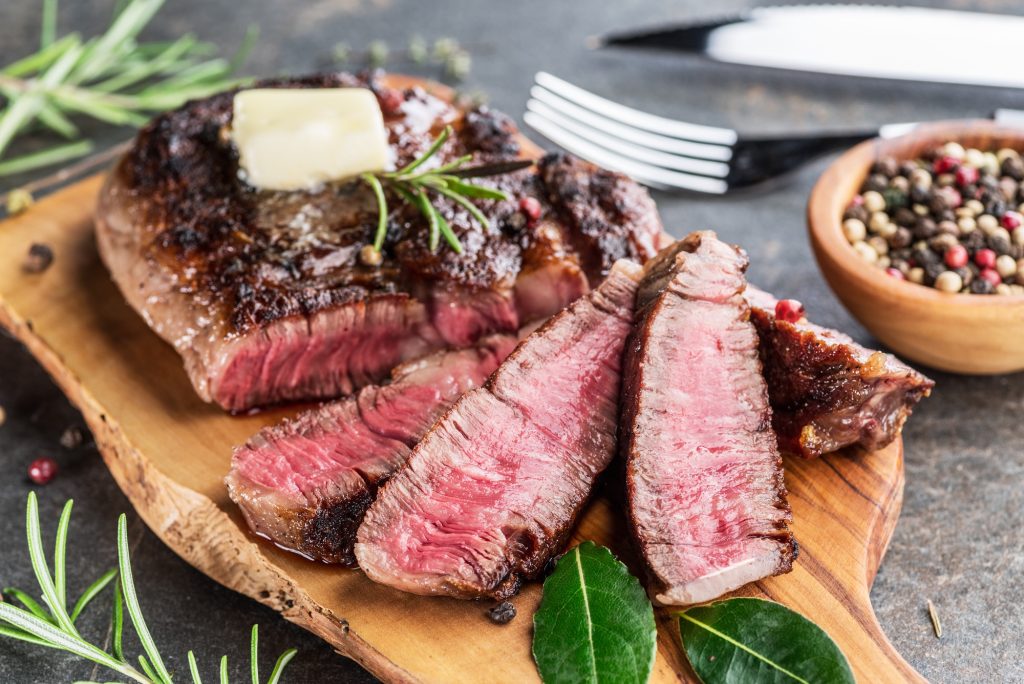The Ultimate Guide to The Best Steak of Your Life
This post may contain affiliate links.
When it comes to a decadent, satisfying meal, it’s hard to beat the succulent, sizzling world of steak. While it can be intimidating to start making steak dinners on your own, the wide variety of cuts and cooking styles means it’s something everyone can master. You often only need olive oil, salt, and pepper to create a masterpiece.

Cooking steak is an art form that requires a combination of skill, knowledge, and appreciation for the rich flavors and textures quality beef offers. Each cut brings unique characteristics to the table, from the tender buttery filet mignon to the juicy and marbled ribeye.
So, let’s explore different cuts of steak, figure out the best cooking methods for each, and get some tips and tricks to elevate your steak-cooking skills from good to gourmet.
Understanding The Different Cuts of Beef
Choosing the best steak cut is essential to achieve the desired flavor and texture. There are so many different options, and you can choose what the priority is for you. Is it a decadent flavor? Or do you want it incredibly tender? Let’s check out the distinct qualities of different cuts.
Ribeye: A Marvel of Marbling
The ribeye steak, derived from the rib section, is known for its exceptional marbling, which consists of intramuscular fat. This marbling contributes to its rich flavor, tenderness, and juiciness. Ribeye steaks are ideal for those who appreciate a well-marbled piece of meat with big flavor.
Tomahawk: The Showstopper
The tomahawk steak is an impressive-looking cut. It’s a thick ribeye steak, with the bone left long and intact. It’s best to cook using high-heat methods, like grilling or searing, and then finish in the oven.
Filet Mignon: Tender Elegance
The filet mignon, sourced from the tenderloin, is revered for its incredible tenderness. It boasts a delicate texture and mild flavor, making it a favorite among steak enthusiasts who enjoy a luxurious melt-in-your-mouth experience.
New York Strip: The Perfect Balance
The New York strip, also known as the strip steak or sirloin steak, offers a delectable combination of tenderness and bold flavor. With its moderate marbling and rich taste, the New York strip is the best option to balance texture and flavor.
T-Bone: Two Cuts in One
The T-bone steak is a showstopper featuring two different cuts in one. With the tenderloin on one side and the strip steak on the other, this steak provides a contrasting experience of delicate tenderness and robust flavor. It offers a combination of flavors and textures for those who appreciate variety.
Porterhouse: T-Bone With More Tenderloin
The porterhouse steak is an amazing cut that combines tenderloin and a strip steak. A porterhouse is the same cut as a t-bone but needs a tenderloin portion measuring at least 1.25 inches in diameter.
Flank Steak: Lean and Flavorful
Flank steak is a lean and flavorful cut from the cow’s abdominal muscles. It has a pronounced beefy flavor and a slightly fibrous texture. Flank steak is best cooked quickly over high heat, perfect for dishes like fajitas or stir-fries. Or, to tenderize it, you can marinate it and cook it on the grill.
Denver Steak: Hidden Gem
The Denver steak, also known as the under-blade steak, is a well-marbled and tender cut from the cow’s chuck area. It offers a rich flavor and a relatively delicate texture. Denver steak is versatile and can be grilled, pan-seared, or roasted. It is a hidden gem among steak cuts and is often more affordable than the ribeye or filet mignon.
Tri-Tip: Flavorful and Juicy
The tri-tip is a triangular-shaped cut from the bottom sirloin of the cow. It is a flavorful and moderately tender cut with a slightly coarse texture. Tri-tip is often seasoned with rubs and slow-roasted or grilled to medium-rare or medium doneness. It is a popular choice for barbecues and roasts.
This list is not exhaustive! There are plenty more to choose from! Most of the abovementioned ones should be easy to find at your local grocery store or butcher shop.
Exploring Cooking Methods
Now we know the different characteristics of steaks, let’s look at the many different ways you can get it on your plate.
Grilling: Harnessing the Flames
- Best for: Ribeye, New York Strip, T-Bone, Porterhouse, Tri-tip
- Why: Grilling is ideal for cuts with higher fat content and good marbling, as the direct heat helps render the fat, resulting in a juicy and flavorful steak. These cuts benefit from the smoky flavors and charred crust achieved through grilling.
Grilling is a timeless and popular method that imparts a smoky flavor and enticing grill marks to the steak.
Preheat the grill to high heat and oil the grates to prevent sticking. Place the steak directly over the flames and cook according to your desired level of doneness (use a meat thermometer to check), flipping it once halfway through. Allow the steak to rest before slicing to retain its juices.
Pan-Searing: Locking In Flavor
- Best for: Filet Mignon, Striploin, Flank
- Why: Pan-searing allows precise control over the cooking process, making it ideal for tender cuts like filet mignon. The high heat quickly sears the exterior, while the gentle cooking inside preserves the tenderness and delicate flavor.
Pan-searing is a versatile indoor cooking method that creates a beautiful crust while ensuring a tender and juicy interior.
Heat a cast-iron skillet over high heat until it’s smoking hot. Add a dash of olive oil or butter and carefully place the steak in the pan. Sear for a few minutes on each side, adjusting the cooking time based on your desired doneness. If needed, finish the steak in the oven, and let it rest before slicing.
Sous-Vide: Precise Perfection
- Best for: Filet Mignon, Ribeye, Striploin
- Why: Sous-vide cooking is excellent for thicker cuts of steak that benefit from a precise and consistent internal temperature. It ensures even doneness throughout the meat while retaining its tenderness. Finish with a quick sear for a flavorful crust.
Sous-vide cooking has gained popularity for its ability to achieve precise and consistent results.
Vacuum-seal the seasoned steak and immerse it in a water bath set to the desired temperature. This gentle and controlled cooking method ensures even doneness throughout the steak. Finish by searing the steak briefly in a hot pan or grill to develop a flavorful crust.
Broiling: Intense and Sizzling
- Best for: Striploin, Ribeye, Denver
- Why: Broiling exposes the steak to intense direct heat, similar to grilling. This method is perfect for cuts with good marbling, as the high heat helps render the fat and create a caramelized crust. Keep a close eye to prevent overcooking.
Broiling is a cooking technique that uses intense direct heat from the oven’s top element to cook the steak quickly.
Preheat the broiler and position the oven rack to the desired distance from the heat source, usually about 3-4 inches. Season the steak and place it on a broiler pan or a wire rack set on a baking sheet. Slide the pan under the broiler and cook the steak for a few minutes on each side, adjusting the time based on your preferred doneness. Keep a close eye on the steak to prevent burning, and allow it to rest before serving.
Reverse Searing: Slow and Steady
- Best for: Filet Mignon, Ribeye
- Why: Reverse searing involves slow-cooking the steak at a low temperature before finishing with a quick sear. This method is ideal for thicker cuts, allowing for an even cook throughout the steak and achieving a perfect balance of tenderness and flavor.
Reverse searing is a beloved method of cooking steak.
Begin by seasoning the steak and cooking it in a low-temperature oven, usually around 275°F (135°C), until it reaches an internal temperature close to your desired doneness. This slow and gentle cooking allows even heating and ensures a perfectly cooked steak. Once the desired internal temperature is reached, sear the steak in a hot skillet or on a grill for a few minutes on each side to develop a flavorful crust.
Pro Tips and Tricks for The Best Steak
Quality Matters: Choose high-quality, well-marbled cuts of beef from reputable sources for the best flavor and texture.
Seasoning: Liberally season the steak with kosher salt, freshly ground black pepper, or your favorite steak rub. Let it sit at room temperature for 30 minutes to allow the flavors to penetrate.
Cook at Room Temperature: Allow your steak to sit on the counter for 30-60 minutes (depending on size) so it rises to room temperature. This makes it easier to cook the steak evenly.
Medium-Rare: Everyone has a preference for how well they like their steak cooked. Try medium-rare. It keeps the steak tender and also brings out the flavor.
Preheating: Ensure your cooking surface, whether a grill, skillet, or oven, is properly preheated to achieve the desired sear and caramelization.
Resting: Allow the cooked steak to rest for at least 5-10 minutes before slicing. This helps retain its juices and ensures a more tender and flavorful eating experience.
Temperature Control: Use a meat thermometer to gauge the steak’s internal temperature for precise cooking. Refer to a temperature guide to achieve your desired level of doneness.
Experiment with Seasonings and Sauces: Explore various marinades, dry rubs, and sauces to enhance the flavor of your steak. From simple garlic butter to balsamic glazes, the options are endless.
So, whether you’re firing up the grill for a backyard barbecue, perfecting your pan-searing skills in the kitchen, or indulging in a luxurious steak dinner at a fine dining establishment, the key is to jump into your steak adventure. While it can take a little time, patience, and practice, mastering the best steak is possible and totally worth it.
This article originally appeared on Wealth of Geeks.
Here are some fantastic suggestions for side dishes to complement your steak:
Cara Campbell
Cara is the founder of The Gourmet Bon Vivant,a food blog that aims to get you to stretch your limits in the kitchen. Whether it’s a new ingredient or cooking technique, TGBV is here to help you make restaurant-quality, gourmet meals from the comfort of your own home (and impress your friends and family while doing it. Cara has been featured in Fox News, Martha Stewart, Yahoo and more. A former broadcast journalist, she’s just as comfortable in front of the camera as she is behind it.
